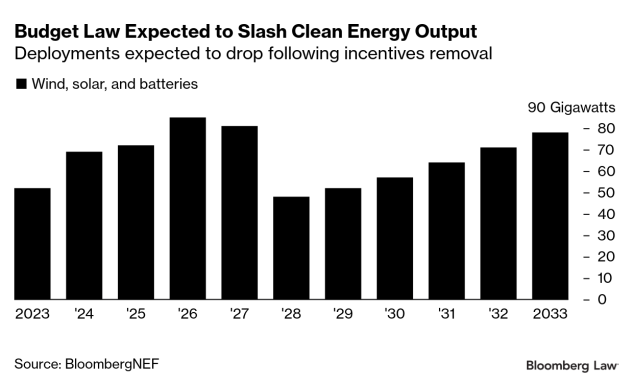- Reconciliation law slashed clean energy credits for projects
- Administration officials increasingly call for more resources
The Trump administration’s urgent messaging about electricity reliability is at odds with Republicans’ removal of tax incentives for renewables such as solar and wind, leaving legal and industry analysts questioning the ability to meet energy demand.
“The combination of a bill that downplays our best and cheapest new sources of electricity and then a report that claims that we’re going to run short in the coming years is absolutely horrendous,” said Joel Eisen, an energy law professor at the University of Richmond.
The reconciliation law signed July 4 terminated multiple energy-related federal tax credits affecting clean vehicles and energy efficiency in homes—as well as limiting access to tax incentives for renewable energy projects.
Shortly after the bill went into law, the Energy Department released a report evaluating the electric grid’s reliability—warning that coal plants shouldn’t be retired due to increased energy demand.
“This report affirms what we already know: The United States cannot afford to continue down the unstable and dangerous path of energy subtraction previous leaders pursued, forcing the closure of baseload power sources like coal and natural gas,” Energy Secretary Chris Wright said in a statement July 7.
The study is just one development in a series of energy moves taken during President Donald Trump’s second term, such as using emergency powers under the Federal Power Act to allow soon-to-be retired coal plants to keep running. Trump on July 18 also allowed coal plants to bypass air pollution rules on grounds that the waivers are needed for national security purposes to meet energy demand.
Though the president has indicated support for more climate-friendly sources like nuclear and geothermal energy, fossil fuels have been the top priority.
“Looking at both of these documents and also the administration’s broader policy, what we really see is this effort to sort of prop up these outdated, expensive, unreliable energy sources at the expense of better alternatives,” said Romany Webb, deputy director of the Sabin Center for Climate Change Law at Columbia University.
Push for More Power
The issue of meeting energy demand is being driven by data centers working on artificial intelligence and extreme weather that strains the grid.
Federal Energy Regulation Commission Chairman Mark Christie (R) expressed concern at the commission’s May and June meetings over fortifying the grid.
Christie pointed out that when dealing with the recent heat waves, grid operators were “tight,” which means “they were at the edge of their resource adequacy.”
While there’s consensus that demand will go up, it’s unclear by how much over a given period of time.
“There’s this sort of inherent inconsistency in some of the different policy actions that we’re seeing from the administration,” said Webb.
While different groups advocate for using only fossil fuels or only renewables, some law professors and utility associations say having a mixture of energy sources makes the most sense.
A “diverse generation portfolio” is a strength because “everything’s got an Achilles heel of some sort,” said John Godfrey, senior government relations director at the American Public Power Association. He noted that wellheads can freeze and wind sometimes doesn’t blow enough.
Alexandra Klass—Biden’s former deputy general counsel at DOE and an energy law professor at the University of Michigan—also recognized the benefits and drawbacks of various energy sources, saying “we need a mix of all of these resources for reliability.”
Still, not everyone agrees the US can afford to keep relying on fossil fuels due to their impact on the climate.
“Keeping fossil fuels on the grid exacerbates our climate disasters, which then end up upending our access to electricity,” said Jean Su, director of the energy justice program at the Center for Biological Diversity.
Impact of Law and Report
Dampening renewables’ abilities will affect what energy resources are available to support the fatigued grid.
“The reconciliation law has an enormous impact on the supply that will be available to meet demand on the wholesale markets, which the DOE says is going to be constrained,” said University of Richmond’s Eisen.
Without the credits, a number of renewable projects “may not be economically viable” or “they may still be able to go forward, but at a higher cost to customers,” said Tim Fox, managing director at ClearView Energy Partners LLC.
If the industry sees “some projects that are in relatively advanced stages of development being canceled, that could exacerbate that supply demand equilibrium,” he said.
There’s also the financial impact of favoring some sources over others.
The final version of the reconciliation law may cut new electricity capacity additions and increase consumer power prices, according to a study from the Energy Innovation Policy & Technology LLC, a non-partisan energy and climate policy think tank.
The goal of the DOE report is to say “‘we need to keep aging coal plants open and not retire them,’ and that’s going to cost consumers a huge amount of money,” said Klass.
Coal involves fuel and transportation costs that don’t come with wind and solar, she said. “There are cheaper ways to get electricity.”
The concerns about the energy mix are set to carry on as the administration continues to focus on investing in fossil fuels.
“We think the report is likely to provide the foundation for DOE to issue more emergency orders to keep preferred plants in service,” Fox added.
To contact the reporter on this story:
To contact the editors responsible for this story:
Learn more about Bloomberg Law or Log In to keep reading:
See Breaking News in Context
Bloomberg Law provides trusted coverage of current events enhanced with legal analysis.
Already a subscriber?
Log in to keep reading or access research tools and resources.

